-
Search
-
Login
-
My Cart
Human milk oligosaccharides are a group of unique prebiotics that are the third-most abundant solid component in breast milk. HMOs are immune-nourishing prebiotics.
HMOs in Similac® are not derived from human breast milk but are manufactured to be structurally identical to HMOs in breast milk.
Similac® 360 Total Care® formulas have 5 of the most abundant HMOs at levels found in breast milk.
In a clinical study, infants were fed an infant formula containing a 5-HMO blend, which was well-tolerated. If you have concerns regarding tolerance, contact your baby's pediatrician.
Research shows that HMOs help support an infant's digestive health by supporting the growth of beneficial bacteria in the gut.
Human milk may have over 150 HMOs, and there is a large range of HMO levels in mothers’ milk. Similac 360 Total Care has 5 of the most abundant HMOs at levels found in human milk.
Similac 360 Total Care formulas contain 2'-FL (2'-fucosyllactose), 3-FL (3-fucosyllactose), LNT (lacto-N-tetraose), 3'-SL (3'-sialyllactose), and 6'-SL (6'-sialyllactose).
If you have additional questions about our blend of 5 HMOs, just give us a call at 1-800-515-7677, Monday through Friday, 8:30 AM to 5 PM ET.
This QR code is not on all containers yet, but we’re working to have it added to all products. The QR code can be found on the lid or back of certain products.
Yes, there are several versions of the MySimilac QR code sticker that you may see on select products. The stickers may look a bit different, but they work the same! They are all valid ways to earn a point and see the quality check information for your product.
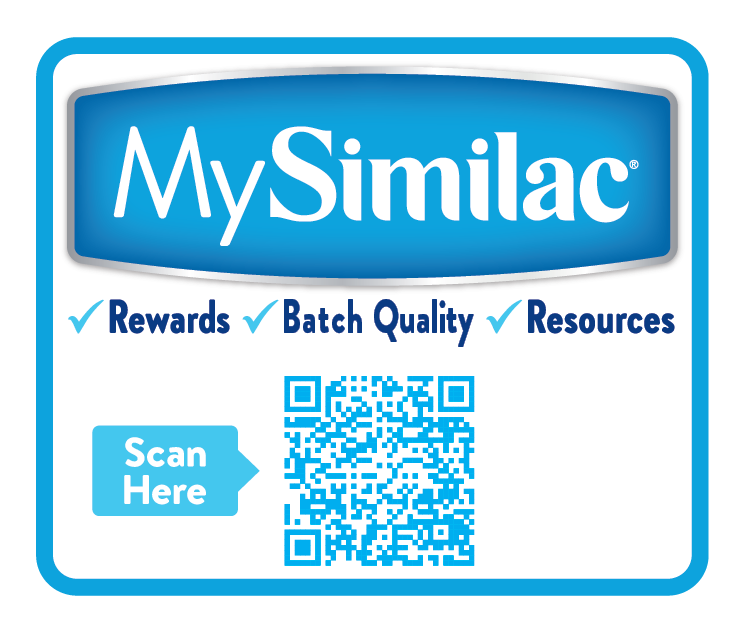
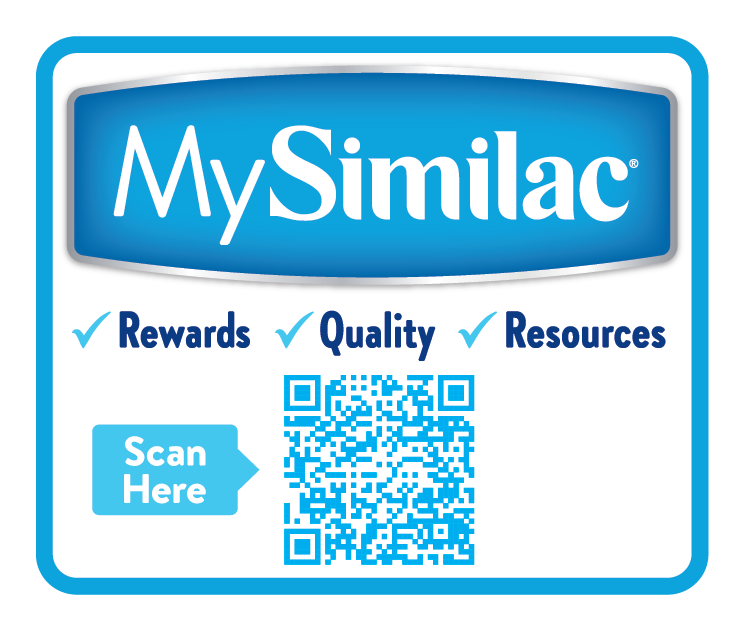
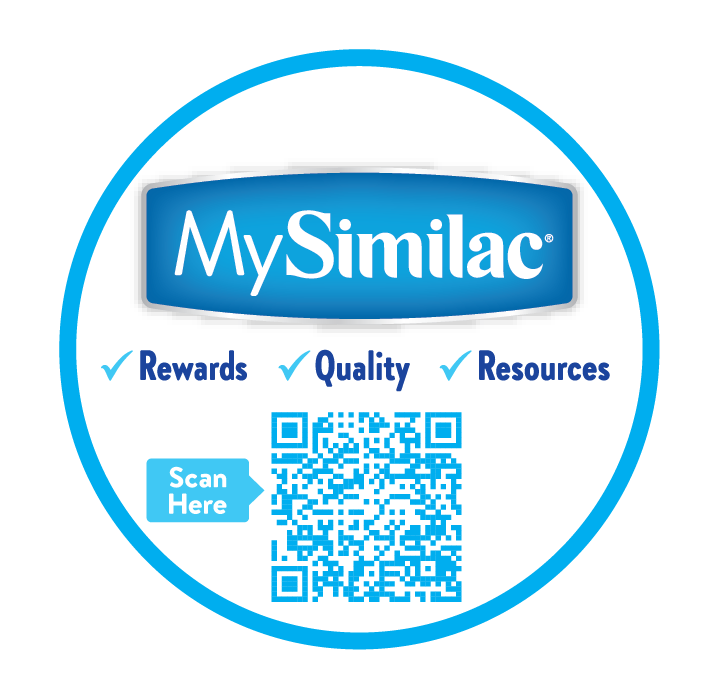
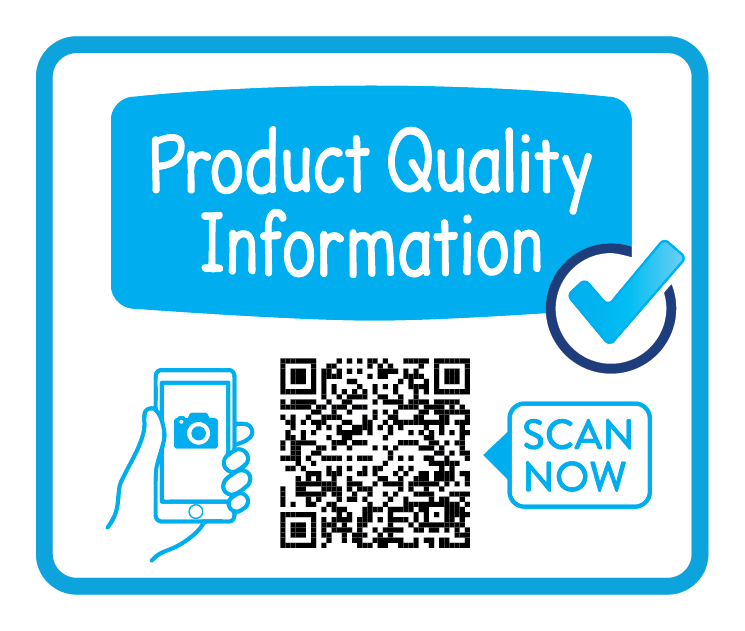
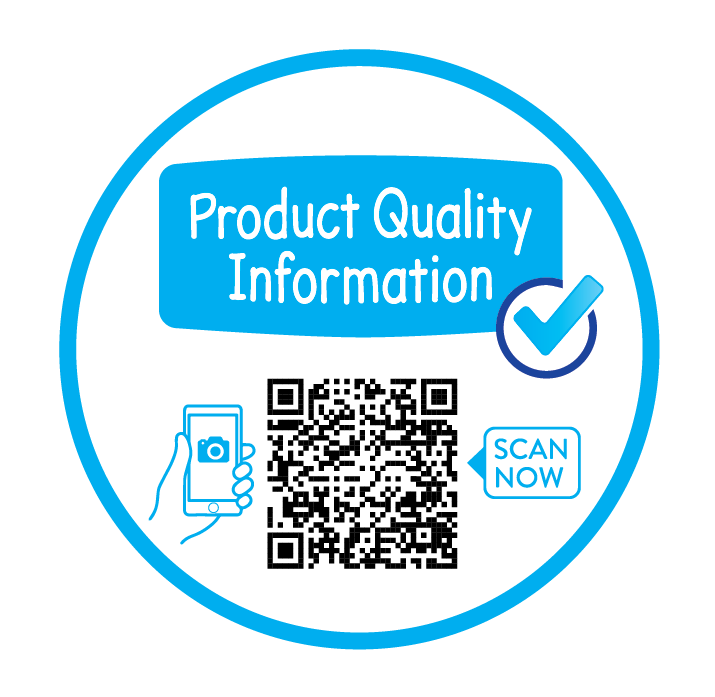
You may see a different "Scan to Save" QR code. This is for new members who still need to register for the MySimilac Rewards program. Points will not be earned for scanning this QR code.
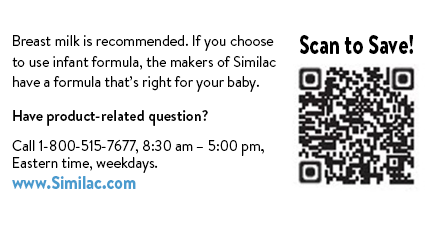
Each powdered infant formula batch is tested for Cronobacter and Salmonella, and it must test negative before the product is released.
Abbott tests nutrients such as fat, protein, and calcium to ensure our products meet Abbott specifications and FDA requirements prior to release.
Abbott conducts testing for attributes such as moisture, aroma, and flavor.
The date that the product is approved to be released from the manufacturer for distribution to customers and consumers is the release date.
No, the release date is the date the formula was approved to be distributed. You will find the expiration date is printed on the bottom of the container or on the side label, and shows the last date the formula should be used.
If you have additional questions about the MySimilac QR code, just give us a call at 1-800-515-7677, Monday through Friday, 8:30 AM to 5 PM ET.
As a Rewards member, you may receive infant formula samples as part of your welcome kit, as well as Similac® coupons. You’ll also have the chance to earn points toward an even bigger Reward and earn a bonus coupon by scanning the MySimilac QR code on select formula products. Plus, get special deals and freebies from our partners—like Shutterfly®!
There are 2 main ways to earn points within the program:
* Limit 5 points from scanning per 35 point Reward.
It can take up to 48 hours for your points to update and for the scan to be reflected in your account. Please check back soon!
* Free Similac comes in the form of a high-value coupon (at least $18 value) good toward the purchase of Similac. For terms and conditions, go to Similac.com.
† Limit of two (2) $5 bonus offers throughout the life of the program. Reward and $5 bonus offer may be earned and delivered separately depending on the individual progress. $5 bonus is awarded after you have reached 35 points, with 5 of those points from product scans.
Once you reach 5 scans and 35 points total, your $5 bonus offer will be delivered to your account in about a week.
Watch the video or go to Similac.com (in Safari) on your iPhone and follow these steps:
Directions apply to Safari only.
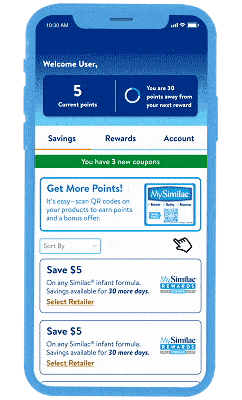
Watch the video or go to Similac.com (in Chrome) on your Android and follow these steps:
Directions apply to Chrome only.
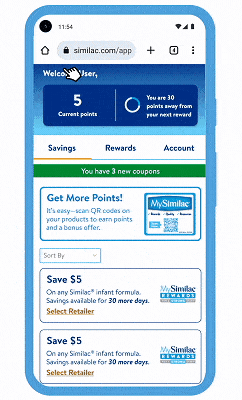
If you have additional questions about MySimilac Rewards, just give us a call at 1-800-515-7677, Monday through Friday, 8:30 AM to 5 PM ET.
For more information, contact our Similac Feeding Expert team at 800-986-8800, Monday through Friday, 8:30 AM to 7 PM ET.
Certain imported Similac formulas are still available at Similac.com and AbbottStore.com.
Each baby is different, so this is very difficult to predict. In general, we have heard from mothers that their babies may take anywhere from several days to several weeks to adjust to a new formula, although some babies adjust right away. It’s always best to consult with your baby’s doctor before making formula changes.
It is always best to prepare according to label instructions. Some countries’ recommendations include boiling water for 2 or 5 minutes. Ask your baby's doctor if you need to use cooled boiled water for mixing and if you need to boil (sterilize) bottles, nipples, and rings before use.
Follow the instructions on the imported formula container for the maximum time allowed to store an open container.
Imported Formula | Comparable US Formula |
|---|---|
Similac Total Comfort (Brown label), 820 g | Similac Pro-Total Comfort |
| Similac Infant Formula with 2’-FL HMO (White and Gold label), 850 g | Similac Advance (similar formulation; no 2’-FL or FOS) |
“Stage 1, 0-12 months” means the formula is appropriate for use from birth until 12 months of age.
EyeQ Plus may appear on some labels and references key nutrients for brain development, including DHA and AA (which means arachidonic acid, sometimes abbreviated ARA).
If you have additional questions about imported formula, just give us a call at 1-800-515-7677, Monday through Friday, 8:30 AM to 5 PM ET.
Pure Bliss® by Similac® infant formulas can be used to supplement breastfeeding. Combination feeding is a great way to keep giving your baby the important nutrients in your breast milk.
No, Pure Bliss® by Similac® infant formulas do not contain glucose syrup solids or corn syrup solids. Pure Bliss® infant formulas use lactose as the primary source of carbohydrate, like breast milk. However, corn syrup solids, which is composed of 100% glucose, have been safely used globally in many reduced lactose or lactose-free milk-based infant formulas for babies who have lactose sensitivity.
Yes, Pure Bliss® by Similac® infant formulas are made without gluten-containing ingredients.
Yes, Pure Bliss® by Similac® infant formulas are all sold in containers free from BPA.
For Pure Bliss® by Similac® Irish Farms: Yes, the metal can is widely recyclable. The scoop and lid are polypropylene and are recyclable, though not all communities participate. You can consult the website earth911.com for recycling information in your area.
For Pure Bliss® by Similac® Organic: The plastic ready-to-feed container is widely recyclable. For the plastic tub (SimplePac), please check locally for recycling information.
For Pure Bliss® by Similac® Organic with A2 Milk: For the plastic tub (SimplePac), please check locally for recycling information.
All Pure Bliss® by Similac® products are made without genetically modified ingredients, have no corn syrup and, no palm olein oil, and the milk comes from cows not given artificial growth hormones.*
*Milk ingredients are derived from milk of non-rbST-treated cows, which is not different from milk of rbST-treated cows.
We have expanded the products under the Pure Bliss® by Similac® name to include our organic products. This was done to organize our offerings with unique milk sourcing that differs from our other Similac® products. Pure Bliss® by Similac® Irish Farms starts with fresh milk from cows in Ireland, Pure Bliss® by Similac® Organic is made in the US with USDA-certified organic milk, and Pure Bliss® by Similac® Organic with A2 Milk is made in the US with milk that is sourced from select cows that only produce the A2 type of beta-casein protein. All Pure Bliss® by Similac® products are made without genetically modified ingredients, have no corn syrup, no palm olein oil, and the milk comes from cows not given artificial growth hormones.*
*Milk ingredients are derived from milk of non-rbST-treated cows, which is not different from milk of rbST-treated cows.
No changes were made to the formulation. These products offer the same great nutrition, just with a new name and label.
If you have additional questions about Pure Bliss by Similac just give us a call at 1-800-515-7677, Monday through Friday, 8:30 AM to 5 PM ET.
It is the same great formulation, just with a new label, and we have updated the name to Pure Bliss® by Similac® Irish Farms.
For a period of time, both labels may be found on shelf depending on retailer and store.
Pure Bliss® by Similac® Irish Farms starts with milk from cows in Ireland.
Imported from Europe, Pure Bliss® by Similac® Irish Farms is a formula that starts with milk from cows in Ireland. Pure Bliss® by Similac® Irish Farms contains milk ingredients without artificial growth hormones,* has no palm olein oil, and is non-GMO.†
* Milk ingredients are derived from milk of non-rbST-treated cows, which is not different from milk of rbST-treated cows.
† Ingredients not genetically engineered.
Pure Bliss® by Similac® Irish Farms is not an organic baby formula. If you’re interested in formulas with organic ingredients, check out Pure Bliss® by Similac® Organic with A2 Milk and Pure Bliss® by Similac® Organic.
Pure Bliss® by Similac® Irish Farms infant formula starts with fresh milk from cows in Ireland, but it is not sold in Europe. Our Pure Bliss® by Similac® Irish Farms products are manufactured in Abbott’s Ireland plant that follows both FDA and EU (European Union) manufacturing regulations.
No, the ingredients are not better because they are from Europe. All ingredients in Pure Bliss® by Similac® Irish Farms must meet both FDA and EU ingredient requirements.
Infant: For baby’s first 12 months of life.
Toddler: For children ages 12-36 months.
It is not recommended that children under the age of 12 months drink Pure Bliss® by Similac® Irish Farms Toddler Drink. The American Academy of Pediatrics recommends that children under the age of 12 months consume breast milk or infant formula.
Yes, both the infant formula and toddler drink have DHA.
If you have additional questions about Pure Bliss by Similac Irish Farms just give us a call at 1-800-515-7677, Monday through Friday, 8:30 AM to 5 PM ET.
Yes, Similac® Organic products are being relaunched under our Pure Bliss® by Similac® line of products. This was done to organize our offerings with unique milk sourcing that differs from our other Similac® products and better help consumers identify the right Similac® product for their baby.
Products labeled “organic” must contain at least 95% organic ingredients, excluding water and salt. Similac® Organic infant formulas contain at least 95% organic ingredients by weight (excluding water and salt) and therefore are classified as organic. Organic food and ingredients are produced without using most conventional pesticides or fertilizers made with synthetic ingredients.
Yes, Similac® Organic formulas provide complete nutrition for a baby’s first year. Similac® Organic uses similar ingredients to other Similac® formulas, but the ingredients meet USDA organic standards.
We create organic formula options to give parents a choice. All our formulas provide complete nutrition for a baby’s first year. No clinical evidence is available to conclude that organic products are better or healthier than non-organic products.
Always check with your baby’s doctor when choosing a formula. All Similac® brand infant formulas, including Pure Bliss® by Similac® Organic, are formulated to be easily digested.
All infant formulas sold in the US are regulated by the FDA. The United States Department of Agriculture (USDA) oversees the organic program.
If you have additional questions about Pure Bliss by Similac Organic, just give us a call at 1-800-515-7677, Monday through Friday, 8:30 AM to 5 PM ET.
Yes, Similac® Organic with A2 Milk products are being relaunched under our Pure Bliss® by Similac® line of products. This was done to organize our offerings with unique milk sourcing that differs from our other Similac® products and better help consumers identify the right Similac® product for their baby.
No changes were made to the formulation. These products offer the same great nutrition, just with a new name and label.
A2 milk is milk sourced from select cows that only produce the A2 beta-casein protein type. A2 beta-casein is similar to a form of protein found in breast milk. Beta-casein is one of the predominant proteins in milk.
Consumers are increasingly interested in A2 milk. As with other milk proteins used in infant formulas, A2 milk protein is naturally easy to digest. Similac® Organic with A2 milk is certified USDA organic formula that is inspired by breast milk and has lactose.
Pure Bliss® by Similac® Organic with A2 Milk is the first certified organic infant formula to be made with A2 milk.
Similac® Organic with A2 Milk is made with milk from select cows that naturally produce only the A2 beta-casein protein type. A2 beta-casein protein is naturally easy to digest, like all beta-casein proteins.
The primary carbohydrate is lactose. The formulation also contains a prebiotic (fructooligosaccharide).
Similac Sensitive® and Similac® 360 Total Care® Sensitive are milk-based formulas for infants with fussiness and gas due to lactose sensitivity. Additionally, Similac® 360 Total Care® Sensitive has 5 HMO prebiotics structurally identical to those in breast milk.
Pure Bliss® by Similac® Organic with A2 Milk is a milk-based formulation with A2 milk as the protein source. A2 milk comes from select cows that produce milk with only the A2 type of beta-casein protein. It is certified USDA organic and like all Similac infant formulas, it is easy to digest. It is not intended for infants with lactose sensitivity.
Similac Total Comfort® and Pro-Total Comfort® have partially hydrolyzed whey protein for easy digestion and are for infants with fussiness and gas due to lactose sensitivity. Additionally, Similac Pro-Total Comfort® has 2’-FL HMO for immune support.
Pure Bliss® by Similac® Organic with A2 Milk is a USDA certified organic milk-based infant formula. Our A2 milk comes from select cows that produce milk with only the A2 beta-casein protein type. Like all other milk proteins used in infant formulas, A2 milk protein is easy to digest. It is not intended for infants with lactose sensitivity, nor does it contain a partially hydrolyzed protein or any HMO prebiotics.
If you have additional questions about Pure Bliss Similac Organic with A2 Milk, just give us a call at 1-800-515-7677, Monday through Friday, 8:30 AM to 5 PM ET.
Yes, most Similac products have OptiGRO, our unique blend of DHA, lutein, and a form of natural vitamin E.
If you have additional questions about OptiGRO, just give us a call at 1-800-515-7677, Monday through Friday, 8:30 AM to 5 PM ET.
On our label, non-GMO indicates that the ingredients in the product are not genetically engineered.
In simple terms, genetic engineering is the science of making changes to the genes of plants or animals. One of the first genetically engineered foods in the US was the tomato. Food experts altered the plant to help a tomato stay fresh longer after being picked.
In the US, unless it’s organic, the milk is likely from cows that have consumed feed from genetically engineered sources. According to the United States Department of Agriculture (USDA), milk from cows fed feed from genetically engineered sources is not considered to be genetically engineered. Think of it this way—the food the cows eat may be from genetically engineered sources, but the milk they produce is not.
Our non-GMO and other formulas have the same ingredients; they just have different sources for the ingredients.
Many crops in the US are genetically engineered. Our US formulas not labeled non-GMO may contain ingredients from genetically engineered crops.
Our non-GMO and other formulas have the same ingredients; they just have different sources for the ingredients. These formulas provide the same nutrition—it’s really just a matter of what a parent prefers.
Yes. We work with our vendors to verify that all the ingredients in our products labeled non-GMO are not genetically engineered in accordance with US standards.
Absolutely. We’re a science-based company, so we always start with what science says. The science is clear—GMOs are safe. The FDA has stated that ingredients from genetically engineered crops are safe to use in foods.
* Ingredients not genetically engineered.
If you have additional questions about our non-GMO products, just give us a call at 1-800-515-7677, Monday through Friday, 8:30 AM to 5 PM ET.
No, your baby shouldn’t need to eat anything else besides breast milk, unless recommended by your baby’s doctor. It is now recommended that all infants and children have a minimum daily intake of 400 IU of vitamin D beginning soon after birth. Ask your baby’s pediatrician about vitamin D supplements and when it’s appropriate to introduce complementary foods.
For women who are breastfeeding, an ideal diet includes a well-balanced variety of healthy foods, including dairy products, fruits, vegetables, grains, and proteins. Most women can maintain a healthy milk supply by taking in about 500 calories more per day than before becoming pregnant. It’s helpful to minimize the amount of empty-calorie foods and eat more nutrient-rich foods. It’s also important to talk with your doctor about their recommendation for a vitamin/mineral supplement. If you notice that your baby becomes upset after some feedings, talk with your baby's pediatrician. No one food or food group should be eliminated from your diet unless your baby has a clear reaction to a specific food.
You can continue giving your baby breast milk while you are away by expressing (pumping) breast milk to be bottle-fed. Many women pump during the day while at work and breastfeed when they are at home.
When you return to work, you will need a breast pump, an appropriate location to pump, a place to store your breast milk (an insulated cooler with ice packs or a refrigerator/freezer), and breast milk storage bags/bottles.
Before returning to work, talk with your employer about your need to pump and the things that will support you and your baby: break times to express your breast milk and a clean, private room (not a bathroom), where you can express milk and clean your pump parts. Your employer may already have an established lactation program to get you started. There are protections for pumping at work under the Fair Labor Standards Act, referred to as the Nursing Mothers Act, that may apply to your place of work. For more information, visit US Department of Labor.
Hospital-grade, double-sided electric breast pumps are available and provide the best way to express breast milk. Retailers also offer double electric pumps. Both are great options if you will be pumping on a regular basis. Some insurance programs offer reimbursement for breast pumps.
If you’re only going to be separated from your baby occasionally, you may consider purchasing a hand pump and/or consider learning how to express breast milk by hand.
For more information on breastfeeding, check out our Breastfeeding Basics.
Let them know they play an important role in feeding time. Studies show that with a partner’s support, breastfeeding is more successful and continues for a longer period of time. To start, they can help position you and baby for breastfeeding, provide you with a drink or snack while breastfeeding, and, if you’re expressing milk, they can take a turn and bottle-feed, which will allow them more time to bond with baby.
If you have additional questions, just give us a call at 1-800-515-7677, Monday through Friday, 8:30 AM to 5 PM ET.
During the first year, your baby will grow and develop faster than at any other time of life. What you feed your baby during the first year supports that development. If you're not breastfeeding, iron-fortified formula is recommended by the American Academy of Pediatrics.
That depends on how much and how often. Many babies spit up a small amount after they’ve been fed. If you are concerned, talk with your baby’s pediatrician about your concerns. If your baby repeatedly spits up or vomits most of a feeding, or if you notice blood in the spit-up or vomit, call your baby’s pediatrician immediately.
Whether you’re feeding your baby with formula only or are breastfeeding and supplementing with formula, it’s important to know the basics of formula preparation and storage. Check out our Baby Bottle Basics to learn more about preparing formula.
Ideally, your baby’s stool should be soft. The stools of breastfed babies are usually yellow, soft/loose, and sometimes seedy. Interestingly, it’s been shown that infant formulas containing prebiotics may help soften stools of formula-fed infants to be more like breastfed infants. For more information, check out our Diaper Decoder.
It's always best to consult with your baby's pediatrician before making formula changes. Switching between different brands of formula may be difficult for your baby to tolerate. Within one brand, you’ll often find a variety of infant formulas are available for different babies’ needs.
If your baby experiences occasional fussiness or gas, ask your baby’s pediatrician about Similac® 360 Total Care® Sensitive or Similac® Soy Isomil®.
Similac 360 Total Care Sensitive can help reduce fussiness and gas due to lactose sensitivity. Similac Soy Isomil is plant protein-based and lactose-free and may help alleviate some of these common feeding problems. In general, babies can take anywhere from 2 days to 2 weeks to adjust to a new formula, although some babies adjust right away.
Some babies will grunt and strain when they have a bowel movement. This, by itself, doesn’t mean they are constipated. If your baby’s bowel movements look like formed, hard balls, try changing to a different form of the same brand of formula (for example, from powder to liquid). Check with your baby’s pediatrician if your baby’s stools continue to be hard after a few days, or if they cry or are extremely distressed with bowel movements.
Yes. Once or twice during a feeding, and after a feeding (usually for the first 6 months), you can help your baby remove swallowed air by burping them. Hold your baby upright against your shoulder, face down across your lap, or upright on your lap while you support their head and chest with your hand. (You will want to place a towel on your shoulder or across your lap or hand, in case more than air comes up.) Then gently pat or rub their back for a minute or so until they burp. Babies don’t always need to actually burp after a feeding, but they should have the opportunity to do so.
It is up to each state to determine which products they will offer through their WIC program. You should check with your local WIC agency to understand which formulas are available in your area.
* WIC is a service mark of the US Department of Agriculture, and an abbreviation for the Special Supplemental Nutrition Program for Women, Infants, and Children. Requires WIC state medical documentation form. WIC state approval is subject to change. No endorsement of any brand or product by the USDA is implied or intended.
If you have additional questions about formula feeding, just give us a call at 1-800-515-7677, Monday through Friday, 8:30 AM to 5 PM ET.
Join MySimilac™ Rewards for up to $400* in benefits and support throughout your journey.
* Offers may vary and are provided by Abbott and its third-party partners. Additional terms, conditions, and restrictions may apply. Offers may be subject to additional shipping and handling fees. Visiting participating healthcare facilities may be required to claim select offers.

† Submit registration to read details.

† Submit registration to read details.

You’re just a few Clicks away from enjoying the convenience of digital savings from MySimilac™ Rewards.